Dauphin Island is an important bird area because of the species who live here or pause for a rest during annual migrations. Even common birds thrive here–pelicans wander along the shoreline, docks, and jetties. The ones here and at Gulf Islands National Seashore are small and multi-colored, with white heads/necks and grey/black bodies rather than being all brown like the California Brown Pelican. I expect to see pelicans near water and would be disappointed if I did not. Afterall, they returned from near extinction from pesticides.

Eastern morph, Brown Pelican
Either way, if a bird could or should be called ugly, it would be the Brown Pelican. In flight they look clumsy. Close up, I see their long, knobby bill and tattered, wind-whipped feathers. After nabbing fish entrails from a fisherman, the awkward brown pelicans flap upwards, with fish guts hanging from their large, gaping mouths.
White Pelicans are the beautiful twin to the ugly browns. The white is more graceful, their flight more steady. On the water they are more swan-like than the bobbing, grubby browns. Their white plumage and golden bills shimmer in the summer sun. I met them inland, around Wyoming reservoirs. The White Pelicans arrived late summer and stayed until late fall. They seemed to enjoy the low reservoirs, which by then had been nearly drained for irrigation. I also learned when I moved to North Dakota, that White Pelicans nest on the prairie potholes. For my birthday, one year, Don the Baptist and I took a day trip to Chase Lake, a refuge and large nesting site known worldwide for their White Pelican population. On a far off island we saw huge numbers fly up then settle back down on their nests. Later that summer I found an entire White Pelican wing among bones scattered around the edge of small lake. No doubt that bird was part of a Great Horned Owl feast. Those big guys will eat anything with a beating heart, including skunks.

White Pelicans

Belted Kingfisher
Today I saw 3 Belted Kingfishers spaced about ¼ mile apart on utility lines, scanning the wetlands for fish. Unlike the Brown Pelicans, the Belted Kingfishers are stylish, compact little bundles dressed in blue, and their hairdo is captivating. A few days ago I saw a Royal Tern, a first for me. His head is white with a dark of feathers which makes him look like a balding guy in a feather suit. Captain Kangaroo comes to mind. he orange bill is super cool.
Birds, birds, bird. Can’t wait to see who flies by next!

Royal Tern



Your comments about pelicans and fish entrails reminded me of a story from years back. My wife comes from the Isles of Scilly, an archipelago of small islands off the southwest tip of England (Google them, you’d be interested) and this happened one year when we were visiting. The most significant occurrence each day is the arrival of the boat, a daily service from the mainland bringing supplies and visitors, in summer several hundred all arriving together. From the quay the majority head down the fairly narrow High Street. On this particular day as the throng surged down the street my Mother-in-Law was gutting mackerel in the garden of her cottage and throwing the guts up to the seagulls. These wily birds had a flight path in turn to her garden but then, beaks full, had to fly down the High Street between the buildings until they had enough speed to climb away at the end and back over the harbour. It was a glorious day, sunny and hot, and in how we enjoyed the sight of all the bare shoulders and necks being splattered with fish blood and guts. Wrong of us I know but you should have been there and I guarantee you’d not have been able to keep a straight face. I’ll leave the image with you.
Thanks for the story! I would have laughed too. One time on a beach a seagull flew down and grabbed a sandwich out of my hands. Crazy birds!